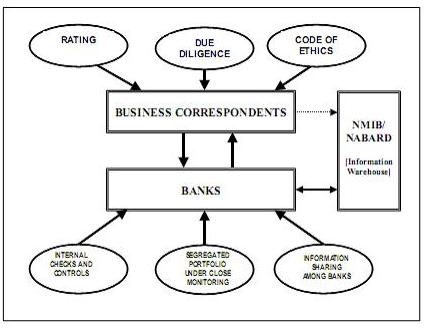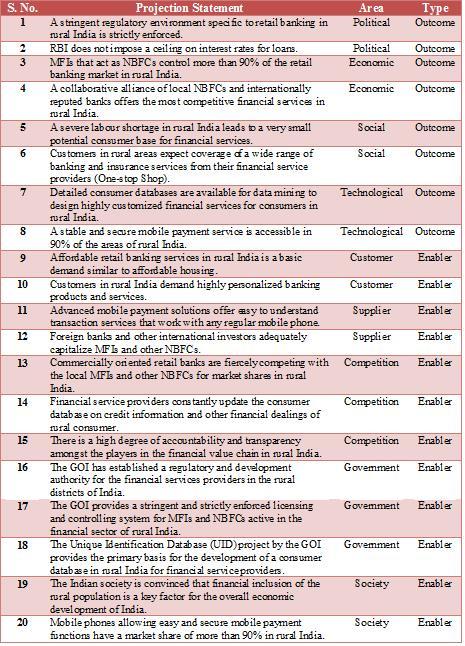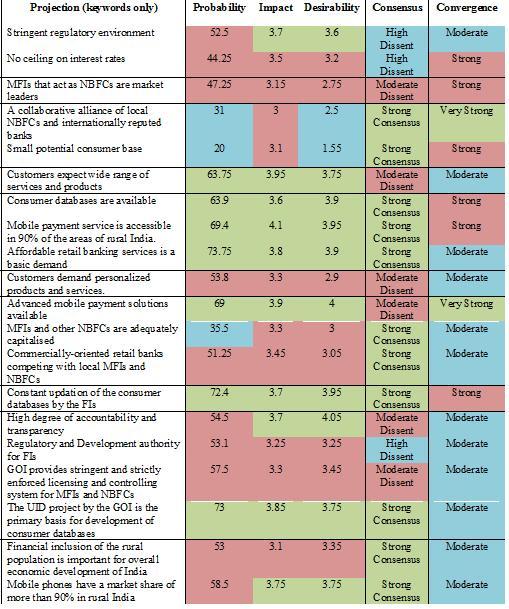Rural Retail Banking in India: 2020
Faculty Contributor : Jayadev M., Associate Professor and Roger Moser, Visiting Faculty
Student Contributors : Madhulika Kaul and Charvi Tandon
Financial inclusion is seen as one of the means for overall economic development of a country. The growth of the rural retail banking industry fosters financial inclusion by providing financial products and services to people in the farthest reaches of the country. In India, even now the rural areas lack access to basic financial services. However, the recent emergence of microfinance institutions (MFIs) and non-banking financial corporations (NBFCs) in this sector has led to a commendable growth in the industry. This study aims to identify the most probable scenarios for the industry in the year 2020 using the Delphi study approach.
The issue of rural retail banking is extremely topical. Over the past few decades, while urban retail banking has seen a lot of growth, rural areas have continued to suffer from insufficient access to financial services. This is mainly due to the requirement of asset deeds, identity and income proofs among other documents by banks and FIs and absence of enough branches in these areas. The high cost of conventional banking is an additional impediment to the realisation of financial inclusion.
Our study has tried to understand how the Indian rural retail banking industry (industry) will develop over the next decade. We aimed to identify the institutional environment of this industry in the coming decade as well as the activities that banks and other financial institutions (FIs) in India will need to invest in to realize the full potential of this market.
Rural Retail Banking
The Reserve Bank of India (RBI) had a mandate to promote rural credit and banking by virtue of the provisions of Section 54 of the RBI Act. Through the State Bank of India (SBI) Act in 1955, the SBI was made an important organisation for extending rural credit to supplement the efforts of cooperative institutions. These cooperative institutions, better known as primary agricultural credit societies (PACS)1 also provide other agricultural inputs to the farmers. The next step to supplement the efforts of cooperatives and commercial banks was the establishment of regional rural banks in 1975 in different states with equity participation from commercial banks, central and state governments. In 1982, to consolidate the various arrangements made by the RBI to promote/supervise institutions and channel credit to rural areas, the National Bank for Agricultural and Rural Development (NABARD) was established.2
Currently, according to a series of estimates and market studies the number of rural bank branches is 31,727. This is 39.7% of the total number of bank branches in the country. The number of no-frill accounts is 28.23 million. There are only 54 savings accounts for every 100 persons in rural areas and only 26% of rural citizens with an annual income of less than Rs. 50000 have a bank account. In the same income bracket, only 13% farmers have ever availed of bank loans while 54% have used non-institutional and other forms of lending3. Thus, there is sufficient need for extending financial services to the rural areas. Exhibit 1 details the supply and demand side factors that challenge the growth of rural retail banking.
 Exhibit 1 Factors influencing demand and supply in the rural retail banking industry
Exhibit 1 Factors influencing demand and supply in the rural retail banking industry
A number of innovations and experiments have been initiated to bridge the gap between the rural population and the formal retail banking system.
- Local area banks (LABs) an initiative that attempted to mobilize rural savings by local institutions and make them available for investment locally. As of 2005, only four LABs were functioning in the country.4 The major handicap in their business model was the lack of a re-financing facility that hindered their ability to lend at better rates.
- Self-help groups (SHGs) with bank linkages was another indigenously developed banking model. Being a savings - first model, credit discipline is a norm of the group; besides joint liability and social collateral make such groups bankable in the eyes of bankers. The linkages are achieved through non-governmental organizations (NGOs) and other intermediaries, and this has formed the basis of the micro-finance movement in India. However, the absence of NGOs in states like Bihar, Uttar Pradesh and those in the north-east has been a stumbling block in spreading this model in these states.
- The alternative to the above model has been the NGO/MFI bulk-lending model where funds were placed at the disposal of NGOs or MFIs for lending to SHGs or other groups and even to individuals. However, this model was not able to scale-up due to the low capitalization of the NGO/MFIs and their inability to undertake financial intermediation. Also, this meant that the formal banks had a two-level exposure and this further reduced the potential for scaling-up.
- In the partnership model, the MFI evaluates, recommends, originates the loans, helps in disbursal and subsequently tracks and collects the loans. However, the loans sit on the books of the bank and not of the MFI. This model has overcome the constraints of capitalization of the MFI and the double exposure that the banks were subjected to.
- Other recent innovations include the Kisan Credit Card (KCC)that enables the farmer to get loans over a three to five year period as a revolving credit entitlement, thus, providing them control over their cash flows and reduced transaction costs for both the banks and the farmers. However, the biggest roadblock has been the creation of point of sale (POS) kiosks and acceptance of the cards.
- The business facilitator and the business correspondent models (Exhibit 2) have been other innovations in this field. Institutions or persons, who interface between the rural poor and banks, are leveraged to provide support services under well-defined terms and conditions by way of contractual arrangements. In the case of the business facilitator model, as per the law, these agencies provide basic support services such as customer identification, collection of information/applications, credit appraisal, marketing etc. Under the business correspondent model, specific agencies e.g. MFIs, NBFCs etc. also provide disbursal of small value credit as “pass through” agents for the parent bank.
 Exhibit 2 Business correspondent model
Exhibit 2 Business correspondent model
Delphi Study Approach
The Delphi study approach has been used to identify and understand the different scenarios that will emerge for rural retail banking in 2020. It is a method for the “systematic solicitation and collation of judgments on a particular topic through a set of carefully designed sequential questionnaires interspersed with summarized information and feedback of opinions derived from earlier responses” Opinions about a certain problem or task are solicited through mail or electronic means in a geographically dispersed network.
The main features of this approach are anonymity to prevent influence of any group members, controlled feedback due to multiple rounds of survey summaries and a statistical output as a final response. It being an iterative and expert based system, the Delphi study approach is regarded as a research technique especially suitable for complex issues. For our study this was particularly relevant since we wished to understand how the rural retail banking industry will evolve over the next decade. Several experts in the field of retail banking, rural banking, rural finance and microfinance were approached through a web-tool and the final opinions of the various experts were studied and analyzed to reach our conclusion and recommendations.
Future Trends in Rural Retail Banking
Based on our secondary research and interviews with experts in the industry 20 projections were formulated for the possible scenario in the industry in the year 2020. These projections can largely be classified into – outcome and enabler projections. Exhibit 3 lists out the 20 projections.
 Exhibit 3 Projections for 2020
Exhibit 3 Projections for 2020
Outcome Projections
These projections concern the actual state of affairs in the industry in 2020. They are a description of a specific situation in 2020 rather than an activity by a specific player in the society. These projections are further categorised under the following four fronts:
Political scenario – A strict regulatory regime is expected for the industry in the future, accompanied with increasing changes in norms and frameworks, primarily, the removal of the cap on interest rates as imposed by the RBI at present.
Economic scenario – The greater share of the market will be serviced by the MFIs and NBFCs. A collaborative alliance with internationally banks will be the primary source of funds and other resources for the MFIs and NBFCs.
Social scenario – Urbanization and migration from the rural areas would substantially decrease the size of the market for the FIs. Even the consumers would become more aware and knowledgeable about the various financial services and products and hence, would expect one-stop shop solutions from the FIs.
Technological scenario – Consumer databases providing information about the credit history and financial dealings of the consumers and thus enabling the FIs to design customized products and better manage their credit portfolio will be put in place. In addition, mobile phones would become the means of the primary delivery mechanism in the rural areas owing to their high penetration and reach and low costs.
Outcome Projections
The other kinds of projections for the industry in 2020 were the enabler projections. These projections pertain to the stakeholders in the industry – customers, suppliers, competitors, government and society. These projections reflect the actions that are needed to be taken by these shareholders to enable the outcome projections.
Analysis of the Projections
The projections formulated for the year 2020 were analysed using the Delphi approach. The various experts who took part in the study were asked to rate the projections on the following counts:
- The probability of occurrence of the respective projection in 2020.
- The impact on the industry if the projection is true. The scale used was a 5-point scale from 1 to 5 where 1 signifies very low impact and 5 signifies very high impact.
- The desirability of the occurrence of the projection. The scale used for was a 5-point scale from 1 to 5 where 1 signifies very low desirability and 5 signifies very high desirability.
Based on the responses of the participants in the study two metrics were calculated for each projection – consensus and convergence.
Consensus
Consensus signifies the consensus among the experts as to the probability of occurrence of the projections. The variance among the responses of all the experts is taken as a measure of the consensus among the experts. A variance of up to 25 is taken as a sign of strong consensus, from 26 to 40 is taken as a sign of moderate dissent and greater than 40 is taken as sign of high dissent.
Convergence
Convergence refers to the changes in the responses of the participants over the period of the study as they studied the responses of the other participants and altered their responses accordingly. It is calculated as the change in absolute deviation of the final responses from the absolute deviation of the initial responses as a percentage of the absolute deviation of the initial responses. An absolute value of convergence up to 10% is taken as moderate convergence, from 11% to 20% is taken as strong convergence and greater than 20% is taken as very strong convergence. Exhibit 4 gives the mean value of probability, impact and desirability and the degree of consensus and convergence for each of the 20 projections.
 Exhibit 4 Metrics for each projection
Exhibit 4 Metrics for each projection
Conclusion
Based on our study we have concluded that the following scenarios are the most probable in the year 2020 for the Indian rural retail banking industry:
- Consumer awareness – with increased education among the consumers and greater availability of information, the consumer awareness will increase regarding the financial services and products that are present in the market and they will demand one-stop shop solutions for all their financial needs.
- Consumer databases – the introduction of the UID project has led to the hope and an increasing probability of presence of extensive consumer databases in 2020. These databases will provide information about consumer credit history and financial transactions to enable the FIs to customize products suited to the consumers’ needs.
- Capitalization of MFIs - there is a low probability that international banks would be the chosen medium of capitalization for the MFIs in 2020. They will be largely capitalized by the local Indian financial markets. This could be owing to the FDI regulations in the country as well as sufficient liquidity in the Indian financial markets.
- Localized institutions – the FIs would work towards designing localized financial services that would serve to provide one-stop shop solutions and remove information asymmetry because of their local presence.
- Mobile-based delivery model – the high penetration of mobile services in the country and advances in secure transfer mechanisms will see the rise of mobile phones as delivery platforms by 2020. This will be further augmented by the low costs associated with this delivery mechanism.
Keywords
Banking, Rural Banking, Microfinance, Rural Credit, Delphi Study
Contributors
Jayadev M. is an Associate Professor in the Finance and Control area at IIM Bangalore. He holds a Doctor of Philosophy (PhD) and a M. Phil from Osmania University, Hyderabad. He is also an associate member of Indian Institute of Bankers. He can be reached at
jayadevm@iimb.ernet.in
Roger Moser is a Visiting Faculty, EADS-SMI Endowed Chair for Sourcing and Supply Management, IIM Bangalore and an Assistant Professor at European Business School. He holds a Ph. D. from European Business School Oestrich-Winkel and an MBA from University of St. Gallen, Switzerland. He can be reached at
roger.moser@iimb.ernet.in
Madhulika Kaul (PGP 2009-11) holds a Bachelor’s degree in Electrical Engineering from Punjab Engineering College, Chandigarh. She can be reached at
madhulika.kaul09@iimb.ernet.in
Charvi Tandon (PGP 2009-11) holds a Bachelor’s degree in Electronics and Communication Engineering from Indira Gandhi Institute of Technology, Guru Gobind Singh Indraprastha University, Delhi. She can be reached at
charvi.tandon09@iimb.ernet.in
Keywords
Banking, Rural Banking, Microfinance, Rural Credit, Delphi Study
References
1 Key note Address by Dr K. C. Chakrabarty, RBI Deputy Governor, at the Review Meet on Implementation of Revival Package for Short Term Rural Cooperative Credit Structure organised by National Federation of State Cooperative Banks (NAFSCOB), New Delhi, 2008
2 Prof. G. Ram Reddy Third Endowment Lecture by Dr. Y. V. Reddy, Deputy Governor, Reserve Bank of India, December 4, 1999
3 “Pushing Financial Inclusion – Issues, Challenges and Way Forward”, Dr. K. C. Chakrabarty, RBI Deputy Governor, SKOCH Summit 2009
4 Report of the Internal Group to Examine Issues Relating to Rural Credit and Microfinance, RBI, July 2005
5 Delbecq, Gustafson and Van de Van, “Group Techniques for Program Planning: A Guide to Nominal Group and Delphi Processes”, 1975, p 10.
